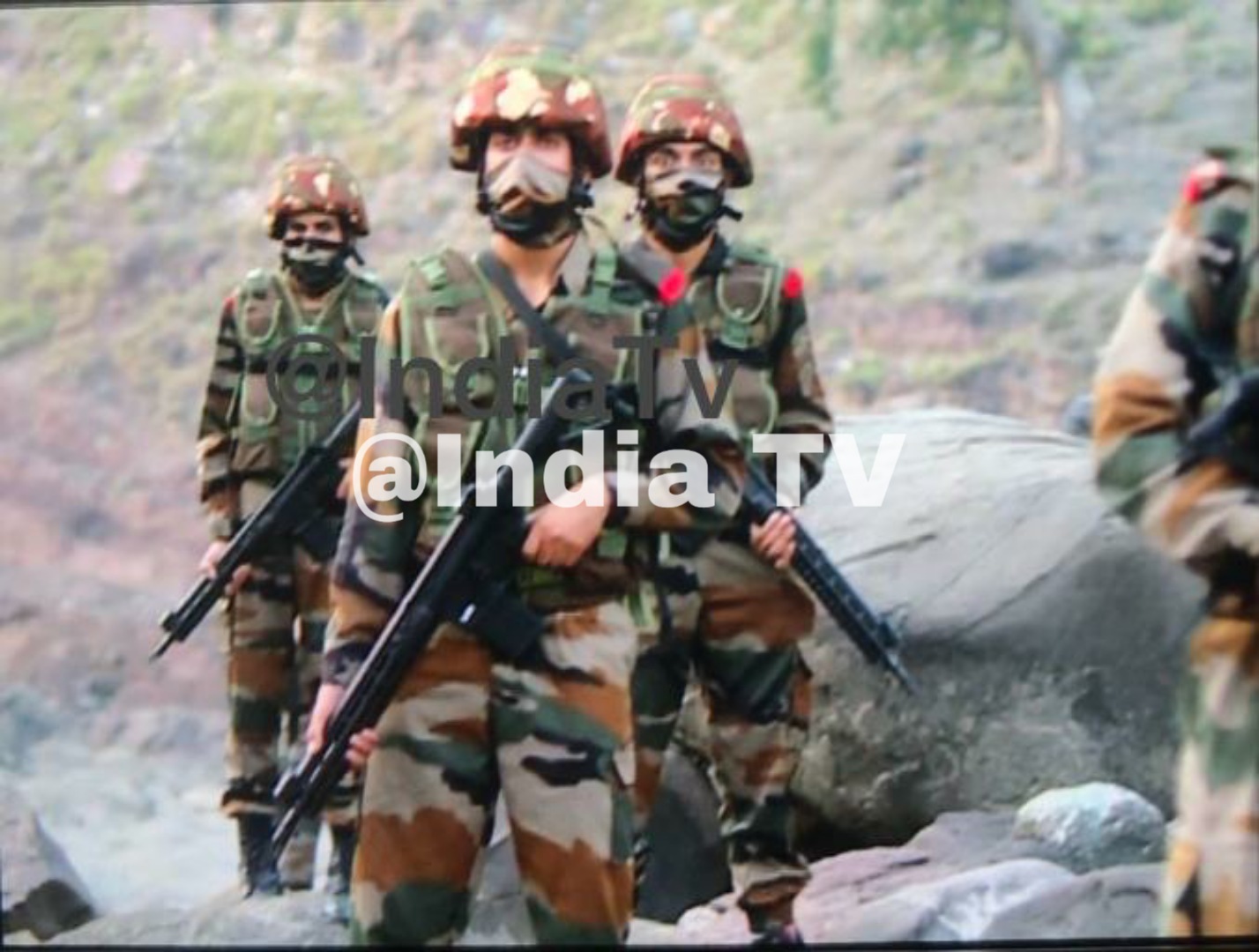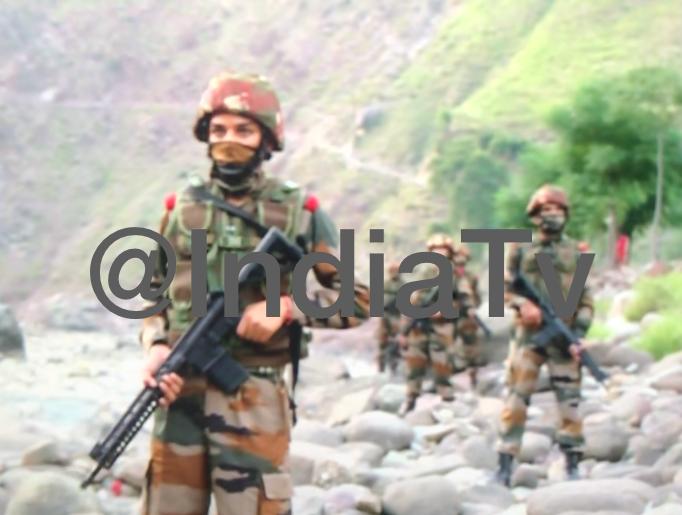Modernisation of Indian Army Infantry
- Thread starter nitesh
- Start date
More options
Who Replied?Unknowncommando 2
New Member
- Joined
- Oct 2, 2016
- Messages
- 5,237
- Likes
- 26,147


New SIG 716 with frontline JAK LI troops
MKU Helmets
Unknowncommando 2
New Member
- Joined
- Oct 2, 2016
- Messages
- 5,237
- Likes
- 26,147
First Look
Beretta M95 AMR

Beretta M95 AMR
porky_kicker
New Member
- Joined
- Apr 8, 2016
- Messages
- 6,030
- Likes
- 44,621
Same stuff again

Behind the table the guy is holding this device
Detachable antenna is not shown in the pic.
It is not to be confused with the larger manportable jammers ( the one on the extreme right of the table ) which is meant to provide protection to larger groups . It is a handheld / clip on jammer . It can also be used in vehicles
Primarily for use by special forces and CI troop for individual protection.
This one is the manportable jammer as seen on the table on the extreme right.
There are 2 other manportable jammer types in use.
All are from an Indian private company.
Last edited:
- Joined
- Aug 28, 2019
- Messages
- 9,954
- Likes
- 60,451
Is it beretta or Barrett
cyclops
New Member
- Joined
- Apr 24, 2016
- Messages
- 1,340
- Likes
- 5,860
I hope somes red dots come soon.

New SIG 716 with frontline JAK LI troops
MKU Helmets
operatorgrumby
New Member
- Joined
- Jun 3, 2020
- Messages
- 151
- Likes
- 535
It's just simple typing error or something like that...a guy of that calliber doesn't makes silly mistakes likes thisIs it beretta or Barrett
- Joined
- Aug 15, 2016
- Messages
- 1,609
- Likes
- 5,849
no optics ? no tonbo ?

New SIG 716 with frontline JAK LI troops
MKU Helmets


Same Camo, Same helmet, same Gun, Same hemet camo for the squad.no optics ? no tonbo ?


Thats the only soothing stuff I see
COLDHEARTED AVIATOR
New Member
- Joined
- Dec 10, 2016
- Messages
- 4,257
- Likes
- 18,272
Optics will be ordered soon..chill.
Unknowncommando 2
New Member
- Joined
- Oct 2, 2016
- Messages
- 5,237
- Likes
- 26,147
Typo. I was too excited yesterday.Is it beretta or Barrett
Unknowncommando 2
New Member
- Joined
- Oct 2, 2016
- Messages
- 5,237
- Likes
- 26,147
Quarter Zip Combat T-shirts in IA Standard camo pattern

WolfPack86
New Member
- Joined
- Oct 20, 2015
- Messages
- 10,571
- Likes
- 16,993
Amid LAC face-off, Army to study lasers, robotics & AI for warfare
| The Army is now undertaking a major study headed by a senior Lt-General on advanced “niche and disruptive warfare technologies”, which range from drone swarms, robotics, lasers and loiter munitions to artificial intelligence, big data analysis and algorithmic warfare. Sources on Friday said the aim of the “holistic study”, which comes amidst the ongoing military confrontation in eastern Ladakh with China, is to bolster the conventional war-fighting capabilities of the 13-lakh strong Army as well as prepare for “non-kinetic and non-combat” warfare in the years ahead. China, of course, has been assiduously working to develop futuristic warfare technologies, like artificial intelligence (AI)-powered lethal autonomous weapon systems, towards its overall endeavor to usher in a major “revolution in military affairs (RMA) with Chinese characteristics”. Indian Army’s new land warfare doctrine in 2018 had stressed the need to sharpen the entire war-fighting strategy, ranging from creation of agile integrated battle groups (IBGs) and expansive cyber-warfare capabilities to induction plans for launch-on-demand micro satellites, directed-energy weapons like lasers, AI, robotics and the like. The new IBGs, after a similar study, have already started to take initial shape as self-contained fighting formations that can mobilize fast and hit hard. Each with around 5,000 soldiers and a varying mix of infantry, tanks, artillery, air defence, signals and engineers, the IBGs were war-gamed in exercises on both the western and eastern fronts last year, as was earlier reported by TOI. “Technology will also be the key driver in future wars. The new study, which is headed by one of the seven Army commanders, will recommend the roadmap for inductions with timelines, along with an overall cost-benefit analysis being done for each disruptive technology,” said a source. The study incorporates AI, remotely-piloted aerial systems, drone swarms, big data analysis, block-chain technology, algorithmic warfare, “Internet of Things”, virtual reality, augmented reality, hypersonic-enabled long range precision firing systems, additive manufacturing, biomaterial infused invisibility cloaks, exoskeleton systems, liquid armour, quantum computing, robotics, directed-energy weapons, loiter and smart munitions, among others. “The Army’s existing equipment, ongoing procurements and long term perspective planning are based on concepts of warfighting which may transform due to induction of these niche technologies. They will accordingly be reviewed,” said another source. The Army’s future military planning will revolve around the effective integration of soldiers and such disruptive technologies into a cohesive war-fighting machinery. It will also focus on enhancing capabilities for 'Grey Zone' warfare, where operations may not necessarily cross the threshold of a full-fledged war, he added. India, incidentally, has already done some groundwork on developing drone swarms or air-launched small aerial systems, which can overwhelm and destroy an enemy’s air defence systems, in a joint project with the US. It is one of the seven joint projects identified under the bilateral defence technology and trade initiative (DTTI) last October, with anti-drone technology called “counter-UAS rocket, artillery and mortar systems” being another one, as was reported by TOI. |
- Joined
- Feb 13, 2020
- Messages
- 1,849
- Likes
- 9,392
Looks badass with the new helmets and all.

Which AK variant is that? That looks proper
Just the normal Bulgarian variant with Israeli upgrade kit.Which AK variant is that? That looks proper
WolfPack86
New Member
- Joined
- Oct 20, 2015
- Messages
- 10,571
- Likes
- 16,993
India’s defence shopping to go desi
A nuclear-weapon state with the world’s fourth largest military depending overwhelmingly on imports to maintain its armed forces: this is the irony that India seeks to overcome on the eve of its 74th Independence Day. The declaration of a list of banned defence imports by the Ministry of Defence (MoD) is a good first step in this direction.
On August 10, the MoD announced an “import embargo” on 101 defence platforms, ranging from bulletproof vests, artillery pieces and unmanned aerial vehicles (UAVs) to radar systems, missile destroyers and light transport aircraft (LTA). Defence Minister Rajnath Singh said that this will result in the domestic industry gaining new contracts “worth almost Rs 4 lakh-crore within the next six to seven years”.
To help Indian companies manufacture defence equipment on the embargoed list, the MoD pledged a “coordinated mechanism for hand-holding of the industry by the defence services”. This is obviously also intended to help policy-makers gauge current and future capabilities of the domestic defence industry “for manufacturing various ammunition and equipment within India,” as the ministry observed.
This means the country’s defence industry now has two options: one, it could design and develop the systems in the negative list on its own; or, it could manufacture the systems by using the technologies developed by the Defence Research and Development Organisation (DRDO) to meet the requirements of the armed forces.
The MoD’s announcement of this negative list, however, need not push up many eyebrows. Last February, at the 11th Defence Expo in Lucknow, Prime Minister Narendra Modi had set a $5 billion target in defence exports for India by 2025. The Prime Minister invited private businesses to invest in the country to realise “handsome returns on investment” and, in the process, make India self-reliant in defence manufacturing.
In fact, the 2020-21 defence budget itself was a clear indicator of New Delhi’s seriousness about the new mantra for defence acquisition: build, don’t buy. So small was the budgetary hike in capital allocation—from Rs 115,350 crore in 2019-20 to Rs 118,534 crore in 2020-21—that it came as a big disappointment for the armed forces which had earmarked a large number of weapons systems for procurement.
However, the focus was on enabling the defence industry, particularly private companies, to boost infrastructure capabilities and augment investments in their weak R&D base. In other words, the Indian military was quietly served notice that it must mandatorily exhaust every other option for developing weapon systems indigenously before turning to the global marketplace to buy ‘off the shelf’ as a last resort. It was a matter of time before a negative buy list—a crucial first step in slashing the military’s import bill—was announced.
It may be early days to speculate on policy reforms like this, especially since several weapons systems included in the negative inventory are already made in India. Some platforms like the LTA are totally indigenous. Singh tweeted that this is only an initial list of 101 types of defence equipment and “more such equipment for import embargo would be identified progressively by the Department of Military Affairs in consultation with all stakeholders.” So this mismatch may be resolved soon.
With the Indian Army and the Air Force expected to buy equipment worth Rs 1.3 trillion and the Indian Navy for almost Rs 1.4 trillion from foreign vendors by 2024, there are misgivings—not entirely misplaced—that private companies could lose out on most of the new deals which will go to defence PSUs.
The saving grace for industry, though, could be New Delhi’s seriousness about raising India’s current annual defence production of Rs 80,000 crore to Rs 1.85 lakh-crore in the next five years. If this ambitious goal is realised, India will become one of the world’s top-five defence producers. As Singh puts it, “For this to happen, the Indian defence industry needs to grow at the rate of 15 per cent per annum.”
With the government backing private industry to play a major role in achieving this target, defence companies will have to substantially augment their current annual turnover of Rs 16,000 crore to meet the indigenous production targets set out in the Defence Production Policy of 2018.
Hopefully, the new defence reforms will result in greater synergy between the private sector and the government. Besides helping India shed its dubious tag of being one of the world’s top importers of military hardware, this may enable the country to build its own military industrial complex based on strategic needs.

 www.moneycontrol.com
www.moneycontrol.com
A nuclear-weapon state with the world’s fourth largest military depending overwhelmingly on imports to maintain its armed forces: this is the irony that India seeks to overcome on the eve of its 74th Independence Day. The declaration of a list of banned defence imports by the Ministry of Defence (MoD) is a good first step in this direction.
On August 10, the MoD announced an “import embargo” on 101 defence platforms, ranging from bulletproof vests, artillery pieces and unmanned aerial vehicles (UAVs) to radar systems, missile destroyers and light transport aircraft (LTA). Defence Minister Rajnath Singh said that this will result in the domestic industry gaining new contracts “worth almost Rs 4 lakh-crore within the next six to seven years”.
To help Indian companies manufacture defence equipment on the embargoed list, the MoD pledged a “coordinated mechanism for hand-holding of the industry by the defence services”. This is obviously also intended to help policy-makers gauge current and future capabilities of the domestic defence industry “for manufacturing various ammunition and equipment within India,” as the ministry observed.
This means the country’s defence industry now has two options: one, it could design and develop the systems in the negative list on its own; or, it could manufacture the systems by using the technologies developed by the Defence Research and Development Organisation (DRDO) to meet the requirements of the armed forces.
The MoD’s announcement of this negative list, however, need not push up many eyebrows. Last February, at the 11th Defence Expo in Lucknow, Prime Minister Narendra Modi had set a $5 billion target in defence exports for India by 2025. The Prime Minister invited private businesses to invest in the country to realise “handsome returns on investment” and, in the process, make India self-reliant in defence manufacturing.
In fact, the 2020-21 defence budget itself was a clear indicator of New Delhi’s seriousness about the new mantra for defence acquisition: build, don’t buy. So small was the budgetary hike in capital allocation—from Rs 115,350 crore in 2019-20 to Rs 118,534 crore in 2020-21—that it came as a big disappointment for the armed forces which had earmarked a large number of weapons systems for procurement.
However, the focus was on enabling the defence industry, particularly private companies, to boost infrastructure capabilities and augment investments in their weak R&D base. In other words, the Indian military was quietly served notice that it must mandatorily exhaust every other option for developing weapon systems indigenously before turning to the global marketplace to buy ‘off the shelf’ as a last resort. It was a matter of time before a negative buy list—a crucial first step in slashing the military’s import bill—was announced.
It may be early days to speculate on policy reforms like this, especially since several weapons systems included in the negative inventory are already made in India. Some platforms like the LTA are totally indigenous. Singh tweeted that this is only an initial list of 101 types of defence equipment and “more such equipment for import embargo would be identified progressively by the Department of Military Affairs in consultation with all stakeholders.” So this mismatch may be resolved soon.
With the Indian Army and the Air Force expected to buy equipment worth Rs 1.3 trillion and the Indian Navy for almost Rs 1.4 trillion from foreign vendors by 2024, there are misgivings—not entirely misplaced—that private companies could lose out on most of the new deals which will go to defence PSUs.
The saving grace for industry, though, could be New Delhi’s seriousness about raising India’s current annual defence production of Rs 80,000 crore to Rs 1.85 lakh-crore in the next five years. If this ambitious goal is realised, India will become one of the world’s top-five defence producers. As Singh puts it, “For this to happen, the Indian defence industry needs to grow at the rate of 15 per cent per annum.”
With the government backing private industry to play a major role in achieving this target, defence companies will have to substantially augment their current annual turnover of Rs 16,000 crore to meet the indigenous production targets set out in the Defence Production Policy of 2018.
Hopefully, the new defence reforms will result in greater synergy between the private sector and the government. Besides helping India shed its dubious tag of being one of the world’s top importers of military hardware, this may enable the country to build its own military industrial complex based on strategic needs.

India’s defence shopping to go desi
The new defence reforms will result in greater synergy between the private sector and the government, and will also help India shed its dubious tag of being one of the world’s top importers of military hardware
scatterStorm
New Member
- Joined
- May 28, 2016
- Messages
- 2,243
- Likes
- 5,360
Where are the comms? No comms?
Unknowncommando 2
New Member
- Joined
- Oct 2, 2016
- Messages
- 5,237
- Likes
- 26,147
FAB DEFENSE MOD + EOTECH

50 RR (Kumaon)
50 RR (Kumaon)
Unknowncommando 2
New Member
- Joined
- Oct 2, 2016
- Messages
- 5,237
- Likes
- 26,147
Quarter Zip Combat T-shirts in IA Standard camo pattern

19th Battalion of SIKH Regiment
19th Battalion of SIKH Regiment
| Thread starter | Similar threads | Forum | Replies | Date |
|---|---|---|---|---|
|
|
Indian Army Says Its New Artillery Chief "Spearheaded Artillery Modernisation". | Indian Army | 8 | |
|
|
Modernisation for Indian 105mm Light Field Guns. | Indian Army | 91 | |
|
|
Update On Indian Navy Force Modernisation | Indian Navy | 14 | |
|
|
How Indian Navy is expanding and modernising | Indian Navy | 0 |
Articles
-
India Strikes Back: Operation Snow Leopard - Part 1
- mist_consecutive
- Replies: 9
-
Aftermath Galwan : Who holds the fort ?
- mist_consecutive
- Replies: 33
-
The Terrible Cost of Presidential Racism(Nixon & Kissinger towards India).
- ezsasa
- Replies: 40
-
Modern BVR Air Combat - Part 2
- mist_consecutive
- Replies: 22
-
Civil & Military Bureaucracy and related discussions
- daya
- Replies: 32
